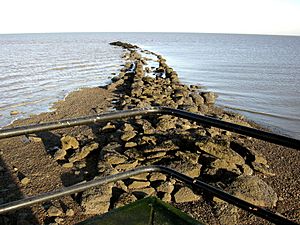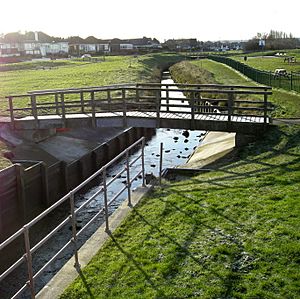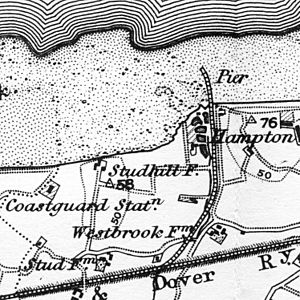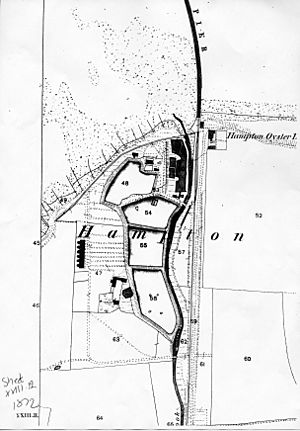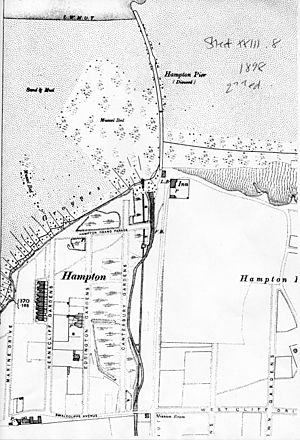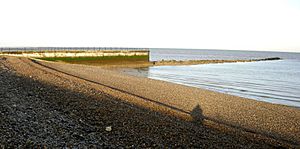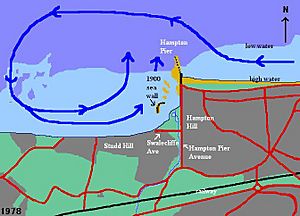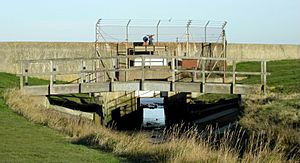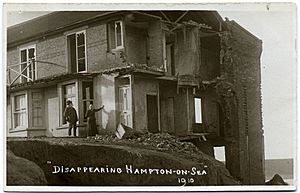Hampton-on-Sea facts for kids
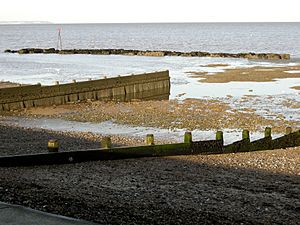
Where houses once stood
|
|
| Location | North coast of Kent, England |
|---|---|
| Address | Hampton Pier Avenue, Herne Bay, Kent CT6 |
| Coordinates | 51°22′14″N 1°05′53″E / 51.37056°N 1.09806°E |
| Status | Drowned |
| Groundbreaking | 1864 (oyster fisheries) 1879 (Hampton-on-Sea Est Ass) 1888 (Land Co) |
| Constructed | 1864–1866 (oyster fisheries) 1879–1880 (Hampton-on-Sea Est Ass) 1888–1899 (Land Co and plotholders) |
| Destroyed | 1916 (abandoned) 1921 (demolished and drowned) 1934 (Hampton farmhouse lost) |
| Companies | |
| Developer | T.K. Freeman (Hampton-on-Sea Est Ass) F.F. Ramuz (Land Co) |
| Technical details | |
| Cost | Hampton Pier £28,000 Plots £3–32 |
| Buildings | 9 houses (oyster fisheries) 8 houses (Land Co) |
| No. of tenants | 17 (Land Co and plotholders) |
Hampton-on-Sea was a village that disappeared under the sea. It is now part of the Hampton area in Herne Bay, Kent, England. The village started as a small fishing spot in 1864. An oyster company helped it grow. Later, land developers tried to turn it into a seaside resort.
However, the village was abandoned by 1916. By 1921, it was completely lost to the sea because of coastal erosion. Today, only a small part of the old pier, the Hampton Inn pub, and some ruined sea walls can be seen at low tide.
Contents
Where Was Hampton-on-Sea?
Today, the Hampton area is the western part of Herne Bay, Kent. The exact spot where Hampton-on-Sea once stood is now underwater. It was located west of Hampton Pier Avenue. You can still see parts of its old sea wall when the tide is low.
When Hampton-on-Sea existed, it was managed by a different local council. In 1934, it became part of Herne Bay. Later, in 1974, it joined Canterbury City Council.
History of Hampton-on-Sea
Early Days
Before Hampton-on-Sea was built, the area was just a few farms and cottages. It was known for its fishing families. People even said that one farmhouse had secret cellars for smuggling. Some cottages were made from old boats. Hampton Farmhouse, built in the 1600s, was once far from the sea.
But the coastline was already eroding, meaning the land was slowly being washed away by the sea. Between 1865 and 1958, the coast here moved back about 175 meters (574 feet). Big storms, like one in 1897, caused serious flooding.
Oyster Farming Village
Oysters were very popular in the Thames Estuary for a long time. People ate them raw. In 1864, the Herne Bay, Hampton and Reculver Oyster Fishery Company was started. They planned to build a pier, storehouses, and homes for workers. They also wanted to create ponds to breed oysters.
The company got permission to dredge for oysters over a large area. They employed many people. They brought in oysters from other places like France and Portugal. Then, they shipped them to London to be sold.
At first, the company did well. But they faced problems like not having enough money. They also had arguments with a rival oyster company. In the 1870s, the oyster business started to decline. Over-fishing became a big issue. New laws were made to protect oysters.
After several harsh winters, many oysters died. The company eventually went out of business. Its assets were sold off in 1881.
The Tramway
A tramway was built to help the oyster company. It ran from the pier south to the railway line. This allowed oysters and supplies to be moved easily. The path of the tramway later became Hampton Pier Avenue.
By 1878, the tram tracks were laid all the way along the pier. The tramway was removed in the 1880s after the oyster company closed. For many years, you could still see where the tramway met the railway.
A Failed Seaside Resort
In 1879, a man named Thomas Kyffin Freeman tried to turn Hampton-on-Sea into a resort. He formed a company and planned to build a bandstand and reading rooms. He also wanted tennis courts and a golf course. He even organized a sports day with free tea. But he died in 1880, and his company eventually failed.
Later, Frederick Francis Ramuz, a land agent, bought the property cheaply. He planned a fancy resort with large houses and shops. He even wanted a church and a pub. The Hampton Pier Inn, which is still there today, became his company's office.
Ramuz divided the land into many plots to sell. In 1888, he held an auction. He offered cheap train tickets and free lunch to attract buyers. Most buyers were from London. All the plots sold quickly. The company made a lot of money.
More auctions followed, with promises of trams and buses. The area was advertised as a quiet place for activities like swimming and fishing. However, very few of the plots were actually built on. The big plans for hotels, churches, and shops never happened.
Why Did It Disappear?
The Hampton Pier's Role
The Hampton Pier was built by the oyster company in 1865. It was very long, about 320 meters (1050 feet). Its main jobs were to help boats dock, protect the oyster beds, and act as a breakwater.
However, after the oyster company failed, the pier fell into disrepair. A big storm in 1897 badly damaged it. Parts of it were removed in 1898 to try and stop the erosion. The pier was rebuilt shorter in 1903-1904. It is now about 107 meters (350 feet) long. The old pier's ruins were a danger to ships.
Tides and Erosion
The main reason Hampton-on-Sea disappeared was erosion caused by the sea. The tidal currents in the shallow Thames Estuary are very strong. When the Hampton Pier was built, it changed how the currents flowed.
Sand and pebbles that usually moved along the beach got stuck on one side of the pier. This meant the beach in front of the new village didn't get new material. The strong currents also created swirling water, called eddies, around the pier. These eddies likely washed away land from Hampton-on-Sea. This explains why new sea defenses are needed today.
Land Issues
Hampton Brook, now called Westbrook, flowed into the sea through a stone tunnel. But seaweed often blocked it. This caused the brook to overflow and become dirty. The land near the brook was low and often flooded, especially during high tides or heavy rain. Also, the ground where the oyster company's fishponds were dug was soft and unstable.
The Village Disappears
Houses were built for the oyster workers in 1866. Later, more villas were added. But the great storm of 1897 badly damaged some of these homes. The sea kept getting closer. In 1899, a sea wall was built, but it wasn't strong enough.
By 1905, much of the planned resort area had been washed away. Storms broke through the sea wall. Houses were abandoned and then demolished as the sea reached their back doors. By 1911, all twelve houses of one street were gone. The last resident left in 1916.
By the 1920s, only a few buildings were left. These were demolished in 1921. This is when Hampton-on-Sea was officially "drowned." The old Hampton Farmhouse, the very last building, was lost in 1934.
What's Left Today?
After Hampton-on-Sea disappeared, new houses were built on higher ground nearby. These became part of Herne Bay. Today, the area has modern homes.
Besides the short Hampton Pier and the Hampton Inn, you can still see the curved shape of the old 1900 sea wall at low tide. This is known as The Rocks. It's now a home for rockpools, mussels, and birds.
New sea defenses were built in 1959-1960 to protect the coast. Where the old houses once stood, there is now a sea wall and beach. An information board near the pier tells the story of Hampton-on-Sea. There's also a walking path along the coast, which is part of the Saxon Shore Way.
Coastal erosion at Hampton-on-Sea was about 2 meters (6.5 feet) per year for a long time. The sea washes away sediment from this coast. Even with new defenses built in 1959 and updated in 1983 and 1994, experts think the sea walls might need to be made even higher in the future.
Images for kids
See also
- Coastal management
- Coastal erosion
- Beach evolution
- Abandoned village
- List of lost settlements in the United Kingdom


